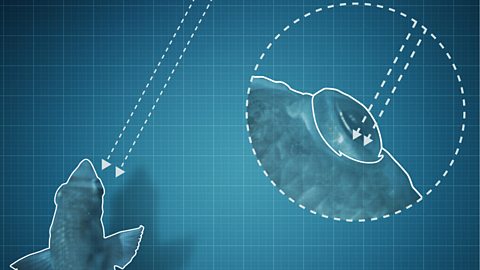The art of archery
Lurking quietly in the rivers and seas around south-east Asia and northern Australia are some incredible fish. They target unsuspecting prey moving around above the surface, knocking them down with a powerful jet of water.
Archer fish can hit their target from under water with pin-point accuracy over distances of two metres. And it is a feat that requires some rather complex physical calculations.
But skill like this doesn't come easy and has to be learned from watching an experienced archer at work, taking hundreds of attempts to master.
Hitting the target
Press start and drag the arrow along to see the breakdown of an archer fish knocking an insect off a leaf with a jet of water.

A master class in physics
To be able to strike a target two metres away from underwater by squirting a jet of water requires not only a knowledge of ballistics, but also of physics and fluid dynamics.
Light bends when it hits the air-water boundary at an angle other than perpendicular to the surface. This is known as refraction and causes a visual distortion for an archer fish looking at prey above the surface. In essence, any potential meal is not actually where it appears to be unless the archer is looking from directly below. Remarkably, archer fish can correct for both large and small amounts of refraction with no loss of accuracy. And if that wasn’t challenging enough, they must also compensate for the effect of gravity on their water jet’s trajectory en route to the target, by precisely adjusting the angle and speed of their spit.
Under pressure
The archer fish presses its tongue against a groove in the roof of its mouth to form a gun barrel-like channel, while simultaneously contracting its gills to force out the watery missile. As each jet is created the archer fish tweaks the flow of water over time, causing a large head of water to gather, hitting its target with greater force. By manipulating the dynamics of the water jet by continuously changing the diameter of its mouth opening and not by altering the pressure, archer fish perform a feat unique in the animal kingdom.
Having done all the hard work in knocking off the intended target, the archer must now calculate the point of impact and be there within one-tenths of a second to avoid losing the meal to one of the audience.

The science behind the skill
Breaking down the skillful hunting strategy of the archer fish in multiple stages.

Image caption, Stage 1: Using its acute vision, the archer fish identifies its prey above the water’s surface. Then with independently swiveling eyes, it focuses the image to take aim.
1 of 4